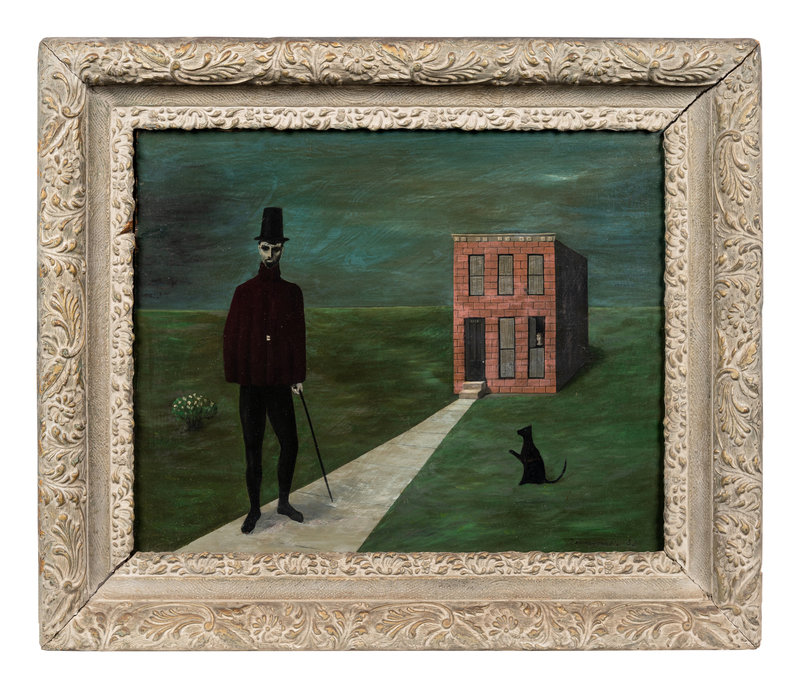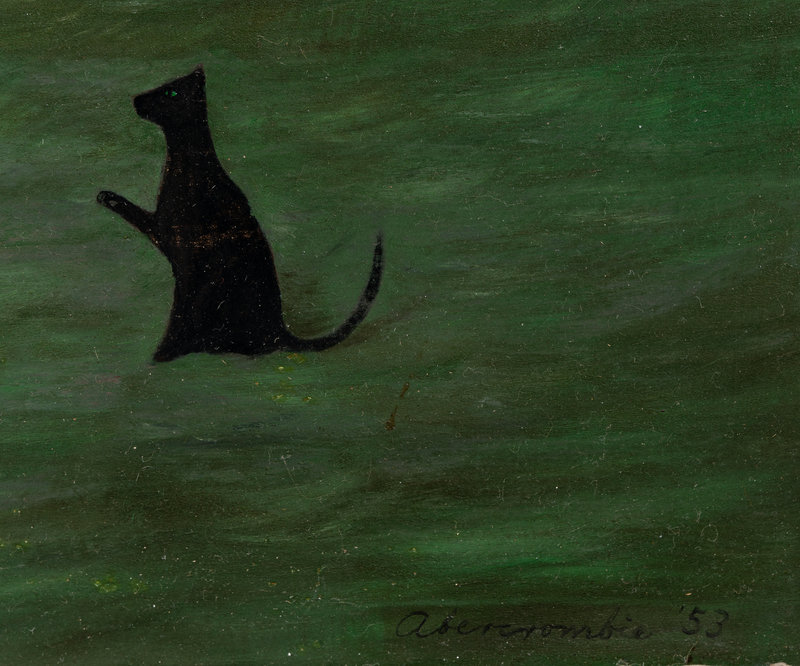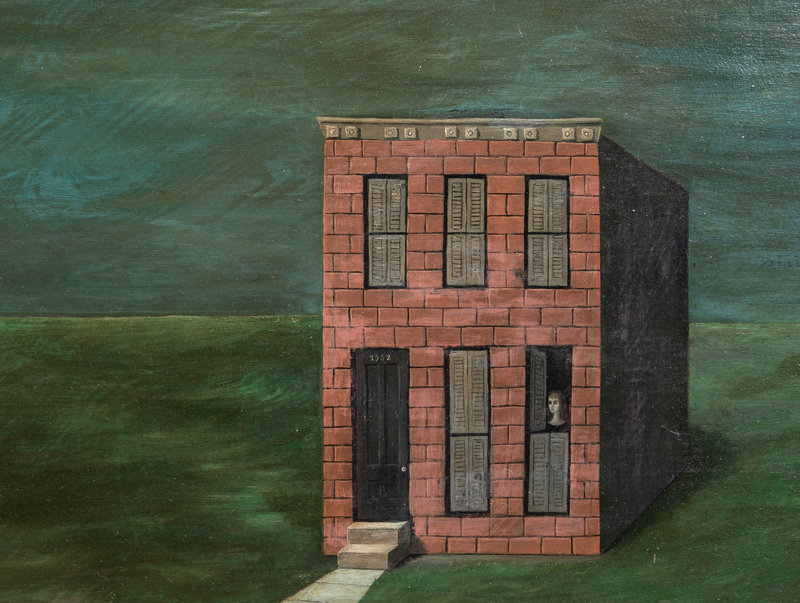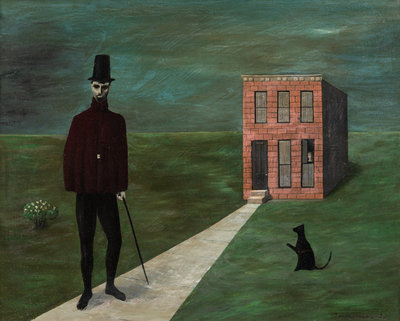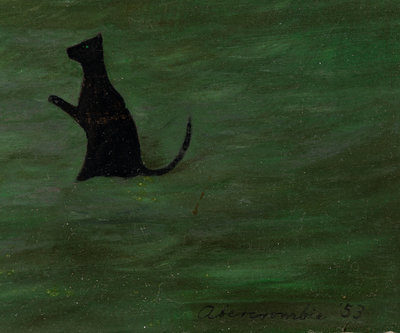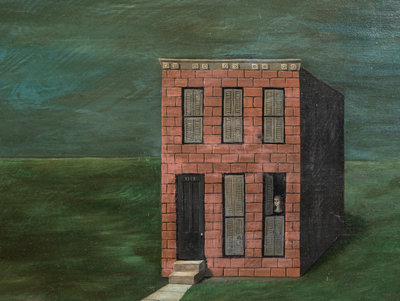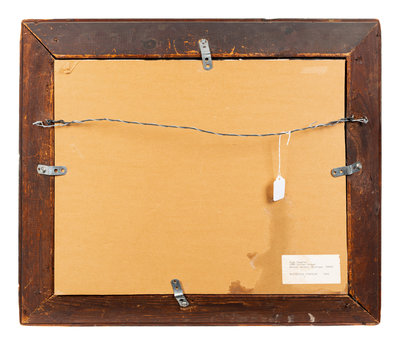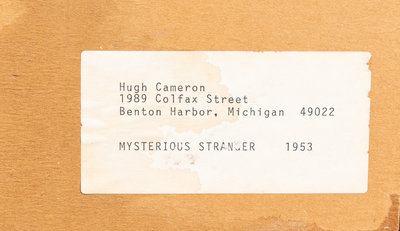Condition Report
Contact Information
Auction Specialist
Lot 49
Lot Description
We are grateful for the research conducted by Susan Weininger, Professor Emerita, Roosevelt University.
Provenance:The Artist
Hugh Cameron, Benton Harbor, Michigan, purchased from the Artist, 1954
Thence by descent to the present owner
Exhibited:
Chicago, Illinois, Hyde Park Art Center, Gertrude Abercrombie, A Retrospective Exhibition, January 28 - March 5, 1977, no. 67
Chicago, Illinois, State of Illinois Art Gallery, Gertrude Abercrombie, March 18 - May 17, 1991 (also traveled to Springfield, Illinois State Museum, July 28 - October 15, 1991), p. 93
New York, New York, Karma, Gertrude Abercrombie, August 9 - September 23, 2018
Literature:
Robert Storr, Susan Weininger, Robert Cozzolino, Dinah Livingston, Studs Terkel, Gertrude Abercrombie, New York, 2018, p. 347, illus.
Lot Essay:
Stranger Things Have Happened
Mysterious Stranger is dominated by the figure of a bearded man in a black top hat, maroon cape, and black pants who stands on a path that leads to an almost cubic house. A woman (Abercrombie herself) appears behind the open shutter of one of the windows, the rest of which are tightly closed. The only other details in the barren landscape are a tiny flowering bush on the left of the composition and a black cat on the right. These elements are familiar in the work of the artist, but as always, are arranged in a unique and original manner.
While Abercrombie often included a female figure that represented herself in her paintings, men make many fewer appearances. Apart from portraits, some done on commission, and a few images of her two husbands, the only other identifiable man that she painted was Abraham Lincoln. Although the facial features of the man in Mysterious Stranger do not look exactly like Lincoln, there is reasonable to believe that he should be identified as the revered President from Illinois. Abercrombie included Lincoln by name in a number of paintings, including Lincoln and Christine (1955, location unknown), an image of an interior space that contains a bust length portrait of a hatless Lincoln on the wall above where the cat Christine plays with a ball; Abe Lincoln (1942, location unknown), a conventional half-length portrait with his top hat resting upside down on a table next to him; and a smaller painting called Lincoln and Tower (Abe and Tower) (1954, location unknown) that was exhibited widely in the 1950s.
Mysterious Stranger is one of three paintings in which a top hatted figure is seen in a landscape, either approaching or retreating from a simple blocky structure. The male figure in each case wears a top hat and black clothing, and in one case, Pink Visit (Lincoln Paying a Call) (1945, private collection) is identified explicitly in Abercrombie’s title. In the other, The Visit (The Night Visit) (1944, location unknown), a woman peaks out from behind the curtains in a window at the front of the house, like that of the woman in Mysterious Stranger. And the top hatted figure appears in yet one more guise, that of a magician, in such paintings as Levitation (1967, private collection) where he stands, arms at his sides behind a marble top table, above which a woman (Abercrombie) levitates.
Abraham Lincoln held a special place in Abercrombie’s heart. As a dedicated Midwesterner who spent her childhood in the small western Illinois town of Aledo and her adult life in Chicago, Lincoln represented values important to the artist. Not only was he a quintessential Midwesterner, beloved by many in the state, but Abercrombie, whose social circle included many Black people, may have found his role in ending slavery even more meaningful. The number of times he appears in her paintings attests to the symbolic importance she attributed to him.
Yet Mysterious Stranger is anomalous in several ways. The top hatted figure is not wearing the typical black suit, white shirt, and tie; he seems to be heading away from the house rather than to it; and the darkened eyes and visage give him a somewhat ominous look. At the same time, the woman looks patiently out the window as if to welcome him or to bid him goodbye. It is notable that Abercrombie encloses herself in an impenetrable space, with an unopenable door and tightly shut windows, except for the one she looks out of. This is consistent with the rooms Abercrombie painted throughout her career, austere and barren interiors linked metaphorically to her internal state. It is possible that the figure is meant to represent a combination of the ideal male, Lincoln, and her current husband, Frank Sandiford, who was all too human. Their 1948 marriage was already beginning to fray by 1953. The lack of communication between the figures extends to the cat (one of the artist’s alter egos) who holds up her paw as if to connect with the man but is isolated and surrounded by the green lawn. The blooming bush is the only sign of hope.
Typical of Abercrombie, the composition is seemingly simple and consists of limited elements arranged beautifully to advance the ideas in the artwork. The diagonal path rushes toward the house and divides the painting, which itself is balanced by the large man to the left and the woman at the window with the large cat directly below her to the right. The number above the door of the house is 1952, which may reference the date the artist began to work on the painting; it doesn’t relate to any address connected with the artist but is the kind of witty detail that is often included in her work. The minimal, unassuming quality of the work is deceptive. The painting’s ambiguity and inscrutability push the viewer to hold conflicting ideas in balance, and complicates what appears to be a simple scene, thus offering more with each encounter.

